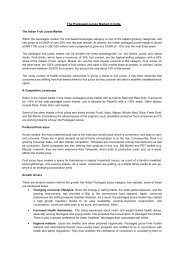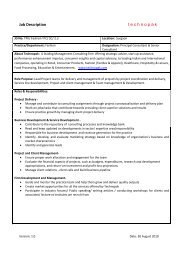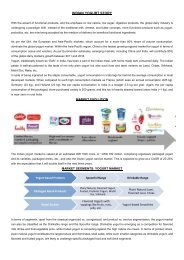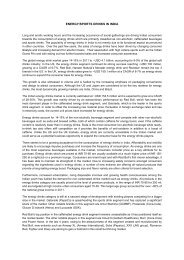The Lavish Indian Market of Imported Food & Wines - Technopak
The Lavish Indian Market of Imported Food & Wines - Technopak
The Lavish Indian Market of Imported Food & Wines - Technopak
Create successful ePaper yourself
Turn your PDF publications into a flip-book with our unique Google optimized e-Paper software.
Made in Foreign: <strong>The</strong> <strong>Lavish</strong> <strong>Indian</strong> <strong>Market</strong> <strong>of</strong> <strong>Imported</strong> <strong>Food</strong> & <strong>Wines</strong><br />
Wine corked at Nasik valley is still not able to fetch the premium which the sparkling bottles <strong>of</strong> red wine from Italy or<br />
France are getting on modern retail shelves. <strong>The</strong> imported tag automatically adds the exceptional sense to the wine<br />
cruet. <strong>The</strong> same mechanism is followed in many other food product categories, like cheese, fruits & vegetables, meat<br />
products, creams etc. In most <strong>of</strong> the <strong>Indian</strong> urban cities, small grocery stores to lavish hyper markets, everyone is<br />
involved in pushing imported food products. On an average 10-15% <strong>of</strong> the total organized retail space is captured by<br />
imported food produce. Since the margin is better, so is the acceptance; Washington apples, Australian Kiwifruit, Swiss<br />
chocolates, French cheese, Italian wine & pastas, are no more a niche for the metro <strong>Indian</strong> shopper. In comparison to<br />
local products, imported goods are heavy on the <strong>Indian</strong> wallet as the aligned taxes & duties are pushed towards<br />
customers. Still the “Made in Foreign” tag is penetrating fast in to the <strong>Indian</strong> shopping basket. <strong>The</strong> rising aspiration <strong>of</strong><br />
urban <strong>Indian</strong>s has paved the way to adopt the tastes from all over the world into their kitchen. Increasing globalization,<br />
urbanization, rising income, growth <strong>of</strong> organized retail, changing lifestyles and food habits have welcomed many<br />
sophisticated food manufacturers across the globe. <strong>The</strong> grass is not greener all the way, heavy import duties and lack <strong>of</strong><br />
infrastructural support still restricts entry <strong>of</strong> many international players on the <strong>Indian</strong> terrain.<br />
<strong>Imported</strong> products have witnessed a higher acceptance in urban <strong>Indian</strong> pockets. <strong>The</strong> experimenting nature <strong>of</strong> the<br />
shopper is encouragement for the importers and the formats <strong>of</strong>fering imported & gourmet foods. By dissecting the<br />
imported food & wine segment <strong>of</strong> India, it can be clearly said that Dairy is the future, followed by wines & packaged<br />
foods. This year dairy imports have witnessed an unbelievable growth <strong>of</strong> 160% from last year, cheese, creams & dips are<br />
some <strong>of</strong> the major products boosting this<br />
growth. <strong>The</strong> USD 185 million imported<br />
dairy market is led by products from New<br />
Zealand & Australia, these two<br />
destinations form 85% <strong>of</strong> the total foreign<br />
dairy products in India. Other emerging<br />
destinations for dairy imports are<br />
Denmark, France & China with impressive<br />
growth rates over last year.<br />
<strong>The</strong> second fastest growing import<br />
category in India is the wine sector, which<br />
expanded 58% since last year. A total<br />
import <strong>of</strong> USD 15 million is majorly from<br />
France, Italy, Australia & Singapore. <strong>The</strong>se<br />
four destinations constitute about 60% <strong>of</strong><br />
the total market. Australian wine is the<br />
new favorite among <strong>Indian</strong>s, import <strong>of</strong> the<br />
same has witnessed a hefty growth <strong>of</strong> 80%<br />
from last year.<br />
2500<br />
2000<br />
1500<br />
1000<br />
500<br />
0<br />
58%<br />
9 15 1 1<br />
-5%<br />
185<br />
70<br />
<strong>The</strong> third category that is growing at a fast pace is packaged food. This segment witnessed a growth <strong>of</strong> 45% over the last<br />
year. Sauces, pastas, chocolates & cocoa products are the major drivers <strong>of</strong> imported packaged food segment. Chocolates<br />
& cocoa products contribute ~55% <strong>of</strong> the total packaged imported food market in India. Singapore, Malaysia,<br />
Netherlands & Italy are the major destinations for chocolates & cocoa preparation in India. <strong>The</strong> four countries contribute<br />
for ~60% <strong>of</strong> the total imports. Singapore has witnessed ~100% growth in demand as compared to the <strong>Indian</strong> market<br />
followed by Italy & Netherland, which have witnessed a demand growth <strong>of</strong> 60% & 55% respectively.<br />
Fruit, vegetables & nuts are the major contributors to the imported food basket <strong>of</strong> India, <strong>The</strong> three segments jointly<br />
form ~80% <strong>of</strong> the total food & wine imports. <strong>The</strong> sector has witnessed a dip <strong>of</strong> ~13% over the last year from USD 3.5 Bn<br />
to USD 3 Bn imports on <strong>Indian</strong> soil. Fruits & nuts as a category is growing with a CAGR <strong>of</strong> 11% but the vegetable category<br />
has descended to a low <strong>of</strong> 26% from last year. <strong>The</strong> biggest category in imported food & wine segment is formed by<br />
“vegetables” (~45%), has witnessed a fall from last year. <strong>The</strong> negative growth is not only associated with vegetables, but<br />
163%<br />
<strong>Indian</strong> Import Basket<br />
2010-11 (USD Mn)<br />
2254<br />
1660<br />
1380<br />
1247<br />
-26%<br />
11% -1%<br />
315<br />
Wine Meat Dairy Vegetables Fruit & Nut Tea &<br />
C<strong>of</strong>fee<br />
311<br />
3%<br />
67 69 46 67<br />
Cereals<br />
Packaged<br />
<strong>Food</strong><br />
2009-10 2010-11 % Growth<br />
200%<br />
150%<br />
100%<br />
45%<br />
50%<br />
0%<br />
-50%<br />
Rounded-<strong>of</strong>f Figures, Source - DoC, GOI , <strong>Technopak</strong> Analysis
meat products, tea & c<strong>of</strong>fee as well. Many international manufacturers are still trying to figure out the <strong>Indian</strong> market &<br />
the association with importers to introduce their product portfolio. However, the success rate is not very impressive.<br />
Many expansion & entry plans are still at hold from various companies abroad because <strong>of</strong> several constraints & chaos<br />
associated with the <strong>Indian</strong> market. Some <strong>of</strong> the key challenges faced by these international giants are:<br />
<br />
High import duties & aligned tariffs<br />
A high import duty on majority <strong>of</strong> food items along with the non-tariff barrier continues to create an obstruction<br />
for importers and manufacturers. <strong>The</strong> added cost gets transferred to the consumer & hinders the adoption <strong>of</strong><br />
imported food. <strong>The</strong> import duty structure ranges from 26% to74% for imported food & wine segment in India.<br />
Regular interventions & recommendations are made towards lowering the duties by different importers<br />
associations and trade commissions. However, the <strong>Indian</strong> government has intervened by amending the duty<br />
structure <strong>of</strong> various food items from time to time, depending upon market conditions and requirements. <strong>Food</strong><br />
inflation has also lowered some import duties resulting in an almost negligible import duty on wheat, rice, corn<br />
and crude vegetable oils. <strong>The</strong> applicable duties cover basic duty, Countervailing Duty (CVD) & Special Additional<br />
Duty (SAD) or special CVD.<br />
<br />
Lack <strong>of</strong> infrastructure support resulting in high lead time<br />
<strong>The</strong> poor infrastructure support in terms <strong>of</strong> transport & storage facility acts as one <strong>of</strong> the major laggards for<br />
imported food segment. <strong>The</strong> integrated cold chain framework is still at a nascent stage in India & the huge<br />
demand & supply gap <strong>of</strong> support infrastructure acts as a constraint in the supply chain <strong>of</strong> imported goods.<br />
<br />
Supply chain constraints blocking the reach beyond metros & mini metro<br />
Majority <strong>of</strong> India lives in rural & semi-urban areas, the supply chain constraints coupled with poor infrastructure<br />
support makes it impossible to reach such markets. <strong>The</strong> huge chunk <strong>of</strong> <strong>Indian</strong> consumers remains untapped<br />
resulting in poor growth <strong>of</strong> the segment. Factually the target segment <strong>of</strong> imported food houses in metros & mini<br />
metros, however if the support infrastructure is in place, the market can be expanded to other cities.<br />
<br />
Stringent <strong>Food</strong> laws<br />
For international manufacturers India is a land <strong>of</strong> stringent food laws which makes it very difficult to enter &<br />
sustain in the <strong>Indian</strong> market. Various Ministries abide by various rules & regulations to ensure entry &<br />
availability <strong>of</strong> safe products for the consumers. Exporters have to follow an array <strong>of</strong> food laws covering use <strong>of</strong><br />
additives and colors, labeling requirements, packaging, weights and measures, shelf-life and phyto-sanitary<br />
regulations. To consolidate different laws pertaining to food & aligned products, Government <strong>of</strong> India has<br />
framed “<strong>Food</strong> Safety and Standards Act, 2006” (FSSA). It concentrates on consolidating various food laws and<br />
works as single regulatory agency in place <strong>of</strong> current multiple regulatory agencies.<br />
<br />
Diverse food habits across the nation<br />
<strong>Food</strong> is like a religion in India, the different cultures make it a home for an array <strong>of</strong> cuisines. <strong>The</strong> nation is known<br />
for diversified & distinct food habits throughout the globe. <strong>The</strong> assorted food habits work as an opportunity as<br />
well as a challenge for food manufacturers sitting abroad. Customizing the product <strong>of</strong>fering according to the<br />
<strong>Indian</strong> platter has gained popularity in recent times, but the same is limited to food services. Catering to the<br />
diversified food habits & fulfilling the expectations in terms <strong>of</strong> quality & affordability will remain as a laggard for<br />
the imported food segment in India.
Preference for fresh and traditional foods<br />
“Fresh is better” serves as a cacophony for food processors in India. Apart from such misconceptions, the <strong>Indian</strong><br />
consumer is also still very much aligned with traditional food, depending on region & culture. <strong>The</strong> awareness<br />
level & adoption <strong>of</strong> processed and packaged food as safe choices are picking up in India, but still serve as a<br />
challenge.<br />
<br />
Affordability Vs Availability <strong>of</strong> similar or better products at competitive prices<br />
India serves as the food basket <strong>of</strong> the world; it leads the production charts in the perishables & grains category.<br />
However the level <strong>of</strong> processing is low but it has picked up in the recent past & the industry is witnessing a year<br />
on year growth <strong>of</strong> 7-10%. <strong>Indian</strong> manufacturers are much aligned with the consumer’s need, as the <strong>of</strong>ferings are<br />
more cost competitive, than imported products. Availability <strong>of</strong> similar or better quality products continues to<br />
serve as a challenge for imported goods in India. On the other hand, better quality imported produce also sets a<br />
benchmark for <strong>Indian</strong> manufacturers to raise the quality level matching the cost effectiveness.<br />
Apart from the above mentioned challenges sourcing also comes as a major constraint in front <strong>of</strong> retailers &<br />
manufacturers. <strong>The</strong> direct sourcing module is still nurturing in India, only few formats like Le Marche adopt partial direct<br />
sourcing from manufacturers around the globe (Thailand, Spain, Italy, etc). <strong>The</strong> direct sourcing approach has only<br />
worked for the large retailers, with either hyper formats or gourmet selections. Apart from these hi-end retailers<br />
(Gourmet/Hyper), all other retailers depend on the distributor cum importers mode for sourcing <strong>of</strong> imported food &<br />
wines. This helps retailers in overlooking the import structure, associated paper work and regulatory licensed<br />
procedures. <strong>The</strong> cost incurred in maintaining the importer/distributor mode can be easily charged to the end consumer,<br />
as imported food anyway carries a pre-conceived notion <strong>of</strong> “Premium” to it. If the above mentioned challenges can be<br />
addressed, then the sky is the limit for imported food & wines in India.<br />
<strong>The</strong> key opportunity areas in the future will revolve around direct sourcing, planting local bases, price betterment,<br />
introducing new products & reaching the untapped market. Apart from these vast opportunities “affordable premium”<br />
will be the next big opening.<br />
Authored by:<br />
Pratichee Kapoor- Associate Vice President, <strong>Food</strong> services & Agriculture<br />
Aneesh Saraiya- Consultant, <strong>Food</strong> services & Agriculture















